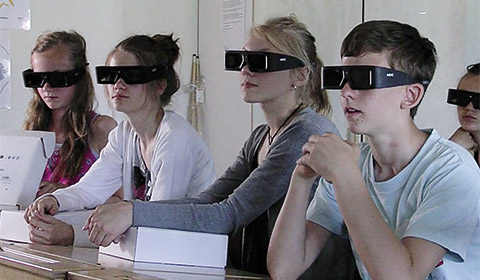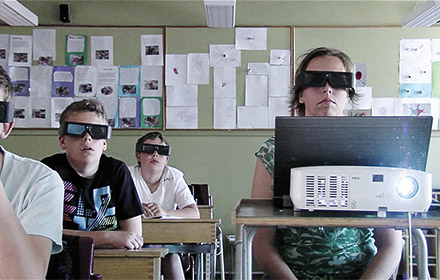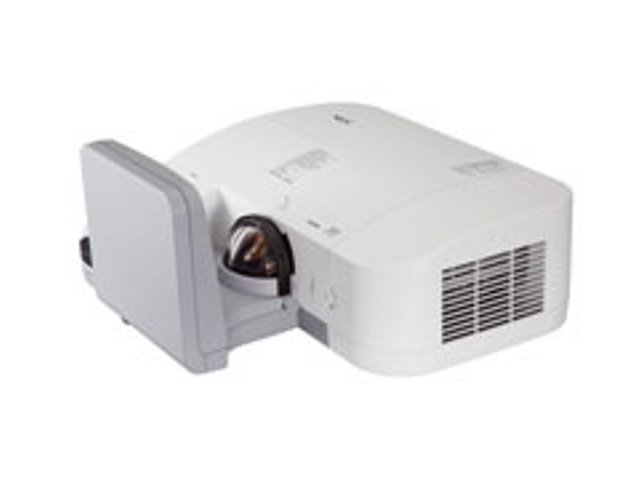NEC Display Solutions Pilot Project Gärsnäs School, Simrishamn, Sweden
I SEE HOW IT WORKS!
NEC 3D DLP® PROJECTORS SUCCESSFULLY TESTED IN SWEDISH SCHOOL
There was no skiving off school today. The boys and girls of Gärsnäs school in Simrishamn, Sweden are concentrating hard and look fascinated at the explanation of how the human heart works. In the next 30 minutes they will get more information about the blood system using 3D technology from NEC Display Solutions Europe. So far the results are more than promising.
This innovative way of learning forms part of a project among a number of international schools. Scientists and experts in education are trying to evaluate how modern 2D and 3D technology makes learning easier and more efficient and can benefit pupils and teachers alike.
The Challenge
The Gärsnäs school is among the leading schools when it comes to modern teaching methods, pioneering education supported by 2D and 3D technologies. Texas Instruments, DLP technology innovator, is supporting the project with technical know-how and the latest hardware. The project, called LiFE 1, is being coordinated by Professor Anne Bamford, an internationally renowned British education expert, who is in charge of delivering the project and evaluating its results. Adapted to the needs of young students, 3D content will deliver greater learning success in all sorts of subjects. Fields like chemistry, physics and biology become far easier to understand for pupils as even the most complex contexts can be presented in a visually appealing form. More and more children are familiar with the 3D experience from movies and video games and are happily adapting to this new kind of learning.

The NEC Solution
NEC offers two different product ranges which support 3D projection with DLP link. One is the V Series, which is a very competitive entry level standard projector range with rich feature-set and low cost of ownership. The more school oriented range however is the ultra-short throw models of the U Series. Ultra-short throw projectors do not have to be installed at the other end of the room or suspended from the ceiling, but let teachers project onto a screen from only inches away. They produce no distracting shadows, and teachers are free to move around the room or stand right in front of the class. NEC’s solutions are pioneering in this field. It has created a range of products with the education sector specifically in mind. “Easy to use, robust enough to cope with day-to-day school life, low noise levels, minimum downtime and low operating and maintenance costs. These are just some of the features that schools and colleges look for,” says Ulf Greiner, Product Line Manager Business Projectors at NEC Display Solutions Europe. “Projects like this give us the chance to gather valuable feedback, which we take and incorporate into the continuous development of our solutions”, he adds.
Short throw projectors are the perfect companions for 3D visualisation. NEC’s new U Series of ultra-short throw projectors are 3D-ready and do not require any additional equipment or modifications, making them a popular choice in the education sector. “Universities and schools are hugely in favour of sustainability, and want products that work equally well in both 2D and 3D situations,” says Greiner.
The entry-level V Series and ultra-short throw models in the U Series all feature the latest in DLP Technology. As with modern 3D capable TVs, the device transmits images alternately for the left and right eye at 120Hz. Active shutter glasses separate out the images meant for each eye so that the image appears three-dimensional to the viewer. The process of syncing a projected image with the glasses is essential, and DLP Technology accomplishes this by sending additional visual signals between video frames, which are picked up by a sensor integrated into the glasses. This eliminates the need for extra emitters and makes the set-up as easy as setting up traditional 2D projection.
The Result

The Gärsnäs school has been testing 3D DLP projection in biology and maths lessons where there are children aged from 12 to 13. Looking ahead that is likely to be extended to a larger group of pupils with a special 3D room. But even today teachers at the school liked the new way of presenting their subjects to students. “The kids pay more attention and get a more in-depth understanding of the topics,” says Madeleine Liwell Jeppsson, teacher at Gärsnäs school. Together with the research experts of the project she tested the differences between groups of students who only got presented 2D content. “The 2D learners were not so good at explaining, for example, the functions of the human heart. There was definitely a big difference between the groups.” For Liwell Jeppson that is a clear advantage of the technology: “With more Swedish language content arriving in the coming months we should expand the use of this technology.”
Bo Erixon, managing ICT strategy for the Executive office at Simrishamn municipality continues: ”ICT is of great importance to find a modern quality assurance of future knowledge and learning achievements of students in Simrishamn’s public schools. We want the schools in Simrishamn to be in the forefront of ICT. The public schools must be dynamic and keep up with the technology and development of society.”So far the research of education expert Professor Anne Bamford proves that the Swedish School is on a positive track in using this modern and efficient method for education. In a first report she describes a distinct, measurable impact in all the schools across Europe that are involved in the LiFE 1 project. “The content that was taught was noticeably more present in before-after comparisons; the children were far better able to retain the material,” according to Bamford. “Many of the children said ‘I understand much better now how the heart works’.”
“It was a great experience for us to see how easily the kids adapt to this technology and how much they like it. It’s great to be part of this development that makes learning easier in a more and more complex world,” says Ulf Greiner, Project Line Manager Business Projectors, NEC Display Solutions Europe. “Everyone involved in this project would have loved to have this technology during their own time at school.”










